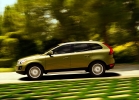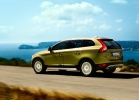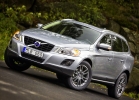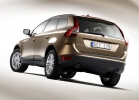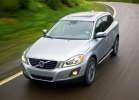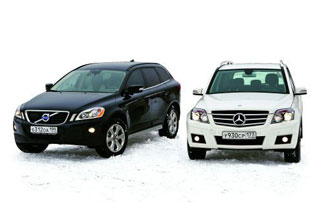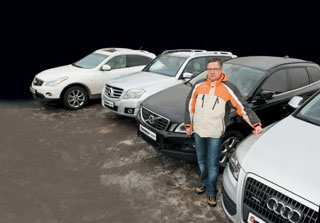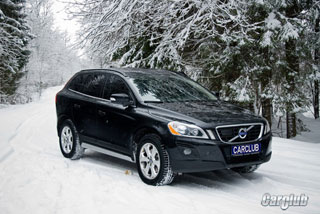VOLVO XC60 test drive since 2008 SUV
In the middle weight category
Spring is the right time to talk about medium -sized crossovers. Although in fairness it should be noted that both of our today's span vehicles are representatives of an inconsistent price range. What does it mean? And above all, the fact that their characteristics and skills! Also much higher than the arithmetic mean. At least there should be. And what do we usually do with such advanced? That's right: we pull, dilute in the corners and drive - into the mud, stands, into specially modeled situations and thus, with a large degree of objectivity, we check their declared abilities.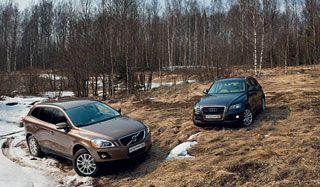


Audi design can not be called either particularly attractive or fresh: there is a rigid adherence to a corporate style. All the same traditional circles and heavy jaw of the radiator grill.
Test of two crossovers? Booping ... Whether it is a matter of some Land Rover to drown the next in the swamp or climb on Jeep in a leales, well, in extreme cases, on the Hummer H2, the king of the earth is to look back ... Okay, work is work. It is habitual to skate a test program at the training ground, make the necessary measurements melancholy, go through a series of tests on the ground, and go home to sleep. Do you think everything was so? By no means! This time, at the Dmitrovsky Auto Polygon, dusty after the winter of the special roads, except boredom. No, true: adrenaline over the edge, engines covering the motor compartments with red light of hot turbines, tires, lifting tens of kilograms of sand and earth into the air ... Yes, I have something to tell! Listen: the seven -rund story of the duel of two interesting beginners in midweight is coming: Audi Q5 2.0 TSFI QUATTRO and Volvo XC60 T6 AWD. So, we start ...
Round 1. Acquaintance with the opponent. There are two approaches to things in the world: consumer, this is when the choice of the totality of useful qualities, and sincere, when I want, despite. So, at first glance it is clear that before us are representatives of these two implacable camps. For example, Audi looks like a typical dream of a middle -level manager, there is nothing to catch on the eye. It would seem that these are painful German body contours with flat sections of wheeled arches can only cause yawning and thought that it was nice ... to take the circuli from designers. But no-something still clings. Either the line of headlights, or the rear LED lights, or something else elusive like an unusual edge of the rear wing transition to the bumper. Nevertheless, only a person in pink glasses can clearly express admiration for Q5 design. Everything is somehow overly corporate and rude. By the way, I presented here how this model will look in pink color ...

Audi Q5 flaunts with new -fangled LED dimensions, and the curved line of lunar light looks completely great.

Built -in in the rear -view mirrors repeaters of the turning indicators have long been not a novelty for a long time. On Q5, they look very neat and elegant, but for some reason they are completely not visible from behind. A logical question arises: what about the requirements of the UN NEC No. 001 and Russian certification? ..
But Volvo, on the contrary, immediately hits the eyes of novelty of elegant forms, forcing him to admire the surrounding reality on his sides and the juicy strokes of rounded lines. Here you don’t remember about the compass, I want to enjoy the appearance of this car, rejoicing that it was not a single aerodynamic pipe. No, however, I am delighted with how simply the designers of this car managed to combine the traditional angularity of Volvo forms with modern cross -improving ease. Not a car, but a photographer’s dream (all angles are good without exception). Yes, and flaunted sensors, radars and video cameras attract no less than stylish two -level hood contours. Here you have the first missed blow to the duel: the glove slipped along the disproportionately heavy lower jaw Audi.

The back optics is again entirely LED. This solution significantly increases the speed of lanterns and has a very positive effect on active safety.


On the right is the Audi wheel disc, and on the left of Volvo ... if you do not look at the lids with the inscriptions, you can confuse. It seems to me that it is time for designers to come up with something new.
Round 2. Reasonable compromises. But inside everything is a little better for Q5. At least some kind of somewhat arises, and parity on the balance of consumer properties. The salons of both cars are quite spacious and have some or another manifesting sports touch to one degree or another. Volvo has a lesser extent, Audi - a little more. Here, designers also dispersed about the right approach to the design of the workspace. And if the key word Q5 is uncomplicated, then for the XC60 the completely opposite concept is stored: stylish. How does all this combine with convenience? Now we will check ... First I sit down in the Audi chair. In German, a hard seat takes me into the arms of lateral support and opens before my eyes the standard instrument panel for the entire lineup (I, with my 190 cm of growth, fit with a margin). The governing bodies are concentrated within the reach of the hands even with a strongly pushed (in my case) seat. Without delights, but solid and convenient, as in the negotiation room of a decent office. Yes, and the Audi Drive Select buttons, switching checkpoints, suspensions and steering from comfortable to dynamic, after the first pressing, they inspire confidence. Only the confused algorithm for controlling the multimedia system with navigation is upset - it is not always clear which of a dozen buttons you need to press and in which direction to turn the joystick wheel to achieve a particular result. It is obvious that this system was built with an eye on Idrive from Bavarian competitors, but it turned out somehow too close. Well, okay, but the navigation is magnificent, the radio reads tracks from the SD format memory cards, and there is a full-fledged dock under the iPod in the armrest (though Volvo has an interface for the iPod).

Volvo XC60 is also made in a corporate style. But how different is the approach! Literally every element here is original, and the lines of the body conceal the size of the car, while creating a rapid and amazingly attractive image.

All modern Volvo models carry a changed logo on the fifth door: the Volvo name is stretched in width. So it was fashionable to draw up a logo in the 60s of the last century, but in our time such spelling is a rarity.
And now I'm climbing to Volvo. No, everything is wrong, the common word is not suitable here. Let's just say: I am going aboard. The sensations from a light salon and an exquisite thin curved plate of the central console cause associations with a small yacht. And the panel of devices with neat scales and alluring lunar lighting completely fascinates. The seats are soft, comfortable, like home chairs by the TV, but with memory in three positions. As for the corchangous curtain, this is generally a work of art. Having admired plenty, I knocked on plastic and ... I hear unexpected sounds. Yes, the materials are not the most expensive. Perhaps only what is made of genuine leather causes a pleasant feeling, the rest is somehow rustic. It’s also a pity that there was no panoramic roof on the tested car - it would add glasses to the Volvo XC60 piggy bank. Well, okay, you quickly forget about this, plunging into the world of buttons, keys, switches and indicators - there are so many of them! And most importantly, the majority is responsible for the functions, to activate which the instruction is not required. Everything is clear at an intuitive level. The only interface of the climate control in the form of a little man is worth it! The lower row of buttons on the central console was completely pleased with the iconograms that were previously unfamiliar to me ... We are talking about the latest distance control system (includes the City Safety braking machine, radar cruise control and collision collision warning indicator), warning systems for approaching marking lines (Lane Departure Warning and Driver Alert Control) and visual indication of the appearance of transport in blind zones of mirrors (BLIS). In general, from the number of innovations, it is simply breathtaking. And in the armrest we also found a phone from a full mobile phone. I understand that now this is no longer fashionable, but not some Bluetooth Hands Free (such a function is also present), but a normal phone in which you can insert a SIM card!

The anterior optics in XC60 is adaptive. In the interpretation of Volvo, this means that the headlights monitor the vector and speed of the car.

The mirror equipped with a BLIS system (in the photo it is visible its sensor) can capture the presence of an approaching car and signal this indicator.
And now briefly about the musical component of the multimedia systems. She pleased and disappointed at the same time. The sound of Dynaudio speakers is very intelligent, sophisticated (not for poppies). I listened to the jazz concert of Igor Butman and Larisa Valley and, not without pleasure, noted the juicy deep voice of the saxophone and a beautiful sound scene. But this is half the age. After all, a huge LCD screen on the central console turned out to be only navigation and no information, except for a completely non-intuitive interface for working with a card and a signal from the rear view camera, does not display! At the same time, the control of the entire sound part is visualized on a small LED display under the windshield, in which you need to peer very closely. It is inconvenient to disgrace. To be honest: during the week of the test (read five days of constant use of the car from early morning until late in the evening) I could not fully get comfortable.

The form of the rear LED lamp Volvo XC60 was not scattered only by the lazy auto -journalist. I am happy to join the majority effective, safe, unusual and very beautiful.

When looking at the car in front, a block of laser rangefinders and auxiliary cameras is striking. These are external tracking sensors behind a strip of movement and device of the City Safety system.
And in the trunk here is a little worse than in Audi. Firstly, the fifth door was on a test car without a servo (it is present at Audi), and secondly, the unaesthetic divider of space rises from the floor and can occupy only one position. But there is a simple comfortable thing. I’ll tell you about a banal hook with a 30-centimeter sling that allows you to fix the floor of the luggage compartment in the open position (getting a tool or a spare, holding a heavy shelf is not too convenient). In general, as for the salons, in this round, crossovers limited themselves to the exchange of blows (or rather, their designation) and hid in anticipation of the main battle.
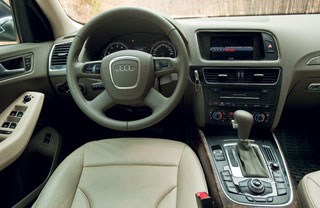
A sign of a VAG concern is a rather boring, but very high -quality interior. And the Audi Q5 is no exception. Perhaps it is worth noting a certain imbalance in ergonomics: everything that is located on the steering wheel and the vertical part of the central console is convenient and intuitive. But as soon as the gaze falls on the console of the gearbox lever, only the parking brake buttons and the volume control remains of the logical controls.


Speaking about landing in the Audi Q5, again you will have to use the beaten phrase traditionally German. Tough, not too convenient, but in the end you can get a job, while the reach of the governing bodies does not suffer at all. And even sitting down behind yourself, it turned out quite comfortably the place behind even for your humble servant (height is 190 cm).


In the luggage compartment Audi is just paradise: two adjustable divisors of space (one hard, one soft) make it possible to calm the bags from a supermarket with an active driving style. There is also a fastener grid for the cargo. True, there was no spare wheel (the niche of the dock is occupied by the dangling and emitting unsalient sizes with a plastic subwoofer).
Round 3. A technical fight. The modern crossover of a rather high class is simply obliged to have the abilities that go beyond the ordinary. These are our fighters. Audi has a whole heap of the latest technologies. Firstly, the amazing engine 2.0 TSFI, issuing 211 hp from its modest volume. And 350 Nm of torque starting from 1,500 rpm! The AVS gas distribution system (includes a stray adjustment of the phase and valve lifting heights), which works in a close connection with an adaptive ignition system with the control of detonation in each cylinder and a turbocharger with smooth pressure adjustment. In fact, today it is almost the limit of perfection for the internal combustion engine, while also fitting into the ecological norms of Euro-4. Another historical milestone in the automotive industry is attached to the motor - a gearbox type S -Tronic with double clutch and a hydraulic transmission inclusion, which allows the most fully used engine capabilities during acceleration. The all -wheel drive here is implemented on the modern QUATTRO system with a self -locking center differential. Well, what is not the ideal?

The two -color salon with a predominance of light tones is elegantly complemented as if in the air with a thin central console made of aluminum ... with the apparent overload, the control of all functions is clear at first glance, and from the second it is completely carried out to the touch. Only the very modest black -white screen of the audio system is upset (not to be confused with the huge navigator monitor).


In the luggage of Volvo, everything is a little worse than that of Audi. Firstly, the fifth door without a servo (at Audi is present), and secondly, the unaesthetic divider of space rises from the floor and can occupy only one position. But there is a very convenient thing: I'm talking about a banal hook with a sling that allows you to fix the open floor of the luggage compartment.


On the driver's chair Volvo XC60, I felt completely free. Let me not have enough side support in the zone of the shoulder blades, but, as it turned out later, this does not discord with the character of the car. But in the back seat I was only thanks to the dexterity and deep exhalation of space for a lifting person here is very small, and in the zone of his knees there is no one at all.

A 16-valve 4-cylinder 211-horsepower TSFI engine with a volume of 2.0 liters with direct fuel injection and a turbine of changed geometry leads a story from Volkswagen Lupo (in 2000, an injection technology bore from the Audi R8 Lemans racing car was presented on this civilian car) .

Today, the bottom of the bottom is one of the main topics. Hence the result ... As you can see, there is no hint of what we call the word protection. All plastic deflectors and fairings.


Meloric front and rear suspensions provide the maximum combination of comfort and sports elasticity. But this is not the main thing in the Audi Q5. The new front suspension scheme with an imaginary wheel rotation center seriously improves handling and can significantly increase stability in corners.


The main study of the elements! How do you like, for example, aerodynamic fairings of springs? And how elegantly a bulky adjustable shock absorber is installed!

The QUATTRO constant all -wheel drive system is finalized taking into account close interaction with ESP and TCS systems. At the same time, it has a fully mechanical scheme with a self -blocking interdose differential Torsen.

The pre-sequentile checkpoint S-Tronic with a double clutch of the latter generation is distinguished by elegant engineering solutions. As an example, you can cite an uncontrolled installation of the front axis shaft, which allows you to get rid of parasitic gears and raise the total transmission efficiency, simultaneously reducing its transverse overall dimensions.
But the representative of the Ford concern can still contrast something. Firstly, a multi-link suspension with an increased center of the roll (its elements were first tested on Ford Kuga). Secondly, the high-speed Instant Traction connection system with high-pressure hydraulic pump (it leads its story from Land Rover Frelander 2). And finally, thirdly, a quick and excellent driving conditions, the 6-speed automatic transmission of the Aisin AW company. Not the last in the weapon list of the Volvo XC60 is also a compact in a row 6-cylinder engine, designed specifically for transverse placement under the hood. With a volume of 3.0 liters, this engine with a double -pressure turbine produces 285 hp. At 5600 rpm, while having an absolutely flat shelf of torque in the widest range: 400 nm@1500-4800 rpm. You will be right if you notice that it is not incorrect to pushing cars with a difference in working volume into a whole liter. But we are also right, because we took as a basis not clean cubes, but the ratio of power to mass.

A separate material can be made about this 6-cylinder in a line turbocharged engine (285 hp). Thanks to the unique layout of the drive equipment drive on one general shaft, he fit under the hood transversely! By the way, the XC60 T6 has an amazingly flat thrust in the entire speed range.

The bottom of the Volvo in terms of aerodynamics has been worked out somewhat worse, which is noticeable much more than the competitor, the number of protruding and undisguised units and parts.

The rear suspension with an increased center of the roll of the car on the long -curved levers is Ford development in the form of a sickle. For the Volvo XC60, it was slightly changed, in particular, alloy transverse levers were installed, which reduced the unsproved masses.

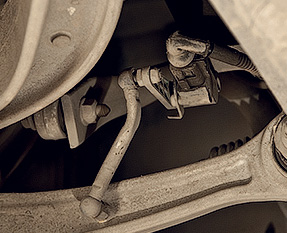
Administers with electronic controls and headlight position sensors are no longer innovation. The future is embodied in metal and plastic, gaining the form of today's day.

Unlike Audi, VOLVO front -wheel drive car with connecting the rear axis ON Demand. To implement this principle, the system, proven on Ford Kuga and Land Rover Freelander 2, is used in the VOLVO marketing classification called Instant Traction.

A car with open connectors at the bottom is clearly not intended for off-rocks. But our tests showed that such solutions on off -road are quite viable ... for a while.
Round 4. Positional struggle. Having drove cars to measuring stands, you can always roughly imagine the results and even do a little predictions. But, as it turned out, not this time. The first illogical result was obtained during weighing. With almost the same overall dimensions (Volvo is slightly higher, but the Audi is wider and longer) the mass of cars differed significantly significantly. In 1902 kg, Audi was still somehow believed, given that the proportion of aluminum in its design was minimal - it was completely iron, but more than 400 extra kilograms of Volvo (2305 kg) looked, to put it mildly, strange. And the Swede was not the best - the advantage on the front axle was ... 700 kg! The heavy engine and the transverse location of the power unit are, of course, an explanation, but not seven centners! A clear and unexpected knockdown in the fourth round! Will the fighter recover, be able to get to your feet?
Well, let's measure the minimum road clearance. Measured. Well, XC60 reassured the fans a little: 215 mm versus 196 mm in Q5 - this is already something. Not so much, but this is a chance to recoup on the off -road. But forecasting controllability at the tip of overturning gave absolute equality. Both cars fell exactly at 52 degrees 20 minutes, which is found in our practice for the first time. Nobody expected from such different cars. This primarily suggests that in high -speed tests of strong differences, we most likely will not see either.

Round 5. Fast battle. The cones on the special road are built in the configuration of the rearrangement exercises. The engines are heated, and in the meantime, our expert drive Evgeny Speransky pulls up the helmet fastener and drives the seat for himself. The air is saturated with the breath of spring and turbo engines ... only one thing is upset - one hundred percent comparison will not work. Cars have different tires. The Q5 has winter, and the XC60 has summer (such a situation, alas, is typical of spring tests). But there is nothing to do, you will have to give a rezine amendment ...

The stabilization system intervened in the Q5 management only in the second phase of the rearrangement (preventing the development of skidding). In the first phase of the action of electronics was not felt.


VOLVO cars are not in vain considered one of the safest and most intelligent. The stabilization system earned at the first rotation of the steering wheel, but so soft and neatly that it allowed the machine as the driver wants.


The parallel start on a high -speed line is, of course, not a full test. But according to its results, we can definitely say that the S-Tronic checkpoint on Audi during acceleration quite successfully compensates for the difference in engine power. Yes, the first meters remained for the XC60, but then the Q5 caught up the lost one, and up to the maximum (221 km/h for Volvo and 215 km/h for Audi), acceleration went on equal terms.
Audi first comes to the start. Several rising passes, and now the maximum speed of the rearrangement has been achieved. The machine creaks on asphalt with winter rubber, a sharp turn of the steering wheel to the left, a noticeable roll, dust from under the rear left wheel and turn the steering wheel in the opposite direction. The stabilization system rudely and assertively sees the car and, peremptorily throwing the riders to the seat belts, levels the car. Excellent, effective and, most pleasant, without a newfangled desire to straighten the trajectory. So, stop ... And what kind of nonsense is this? Observers, headed by the photographer, note the mysterious algorithm for the work of the stop signals. With automatic branding by wheels of one side, the lanterns of the same side are light and are lit. Why is this yet? Why not use both lanterns? Indeed, from the point of view of the driver traveling behind, this is just a blown light bulb, not only not carrying any additional information, but also negatively affects safety. Having recorded this in the oddity section, we go to the Volvo test.

On the mountain road, the Audi Q5 performed in all its glory: a great feeling of the car (partly merit of the S-Tronic checkpoint, which provides a rigid connection of the engine and wheels), neutral rotation, almost complete non-interference of the track control, and as a result, pure pleasure from driving. Volvo, with his tendency to turning insufficient, worked no less efficiently, but with an emphasis on safety. That is, the actions of the driver, different from the right ones, gently, but persistently suppressed. The car was not felt at all like boring, only adding confidence in the turns.
Acceleration, leveling of speed by 75 km/h, readiness. We go to the corridor of cones, a jerk, a short creak of rubber, and ... a smooth neat intervention of the stabilization system after the first rotation of the steering wheel! Great: the car recognizes a dangerous maneuver at its beginning, but leaves the right to control entirely for the driver. That is, he continues to reduce speed to safe and extremely intelligently helps to steal in braking. Bravo!

The passage through the broken cobblestone was shown by the reluctance of the Audi Q5 to move quickly along such roads. Already at 70 km/h it pierces the suspension, and the car loses stability. Volvo, on the contrary, refers to such coatings indifferently, calmly practicing an irregularity suspension up to 80 km/h.
But the rearrangement is not even half the age. Well, if so, we go to the mountain road ... At one time, I already told how I love this high -speed highway of the Dmitrov auto policy. I’ll say more: if you do not take off-road, this is my favorite part of the test. Serpentines, climbs, descents and turns of various radii. In general, a dream, not a road. But something I was distracted ... After the first races, it became obvious: the overload of the anterior axis XC60 has a very significant impact on the behavior of this Volvo, which is manifested in pronounced insufficient rotation, aggravated by the desire of the vigilant ESP to fully protect the driver. That is, the machine fundamentally stops all attempts to fuck. Solidity is the Volvo style.
Audi, on the contrary, showed himself to be fervent. Later, the operation of stabilization systems affected the opportunity to send a German crossover in a small skid and turning turns is much more effective. Even the track control did not interfere (almost did not intervene). Here you have the characters. True, to the question: who beat whom? There was no answer, and no. Different tasks were already painfully set to developers. And in general, who said that they will go only on asphalt? ..
Round 6. Rainty style. Country roads and cute forest primers - this is a typical habitat of the crossover. Well, if there is all -wheel drive, rarely someone will resist the thought: but do not grab me into Karelia?. So we check how the driver and passengers will feel on light off -road. True, our obstacles are artificial - various kinds of bumps. Let's start with those that are smaller - with a cobblestone pavement, which will allow you to evaluate the ability to drive a car on a broken dirt road. Moreover, both machines can adapt the suspension to the current conditions.


At the alternating obstacles, Audi is not only shining, but moved confidently (an off -road part is clearly present in the electronic systems program). Inhibiting the wheels that have lost the adhesion to the surface occurs on time and gives a clear effect of progressive movement. The same is also facilitated by sufficient angles of entry-sitting.
So, the first is Audi. Suspension switch - in car mode, speed - 30 km/h, I drive into the cobblestone ... Well, roar! In the first second, there is a feeling that someone dismantled a magnificent isolation that seemed a minute ago. I increase speed to 40 km/h. There are no changes, except that it shakes a little stronger. At 70 km/h, the car seems to begin to adapt the suspension, because the move becomes ... softer, but at the same time there are hard holes. You can’t accelerate further, I’ll still break something.


But the XC60 of the off -road program did not have ... Perhaps it is, but too invisible. The result is banal: the test for overcoming artificial obstacles was given to the car hard. On the other hand, if you have a decent initial speed (for example, 35 km/h), then there will be no problems. Unless the plastic can suffer ...
Now the turn of the golden handsome Volvo. Here the situation with the suspension is unusual - it is the fastest that is the most quickly at the sporting mode of Advanced. And only because the speed of working out adaptation is the least. First, it shakes that it throws up to the ceiling, but after a couple of seconds everything calms down, and up to 80 km/h the car holds the straight line without losing the course stability (there is no breakdown of pendants). As for the noise, the XC60 prize in this nomination is also in this nomination: I won’t say that the cabin is very quiet (and you wouldn’t believe it), but in the Swede much quieter than in Audi. Now let's lower the speed to the minimum and move on to the larger bumps.

The work of the volvo summer rubber in the snow, as expected, was reduced to rubbing ice heel and a complete stop for each of the possible reasons.
Summarized obstacles are a good way to find out the limits of geometric patency, suspension stroke and evaluate in the first approximation the work of the track control of the track control. And this is what we did. Firstly, Volvo has such a program ... no. The system of brakes of hanging wheels (mainly the rear, since the machine stubbornly did not want to bully the wheel of the front axis) turned out to be so ineffective that I could hardly overcome three rangers, and even then only thanks to the movement. No stabilization systems are disconnected - they do not go, and that’s it!


On this exercise (climbing a small mound), both cars behaved more or less decent for crossovers. Volvo skidded and sorely climbed up. And Audi ... could not figure out his two clutches and understand which transmission to include. As a result, at the top of the rise, under the discharge of gas, Q5 actively slowed down and ... jammed the engine.
With Audi, everything happened exactly the opposite. Firstly, when pressing the ESP OFF button, the ESP Offroad inscription lit up on the screen, which in itself pleased. Well, and secondly, a self-locking inter-sequent differential, as well as ineffective, but still allowing the system of slowing down the hanging wheels that allowed to move forward, worked in a pair. It was possible to slip only with completely provocative actions. As for the cross-country ability is geometric, both cars in a couple of times struck the rag of ranger with aerodynamic shields and other plastic details, but this did not stop the progressive movement. Well, what can I say ... The situation is slowly clearing. And it's time to clarify her completely and irrevocably. The main battle is coming - a test of the spring thaw.

Movement along the sandy slope was given to both cars with great difficulty. It is not known what the result would be if there are identical tires, but in this case it turned out that the Volvo highway had clearly more chances. The car moved, not having time to instill deeply, while the Q5 instantly dug under the wheels of the pit and lay on the ground.
Round 7. Dirty techniques. The weather during the test was magnificent. The sun was already thoroughly flooded with snow, giving off -road to the power of the fragmented clay and raw grass. On the one hand, for checking crossovers - it is not the most, but on the other hand - how are they worse than the rest? Or in the spring they do not ride cottages? Here, however, it is worth mentioning the differences in the established rubber again, because the Audi winter should cling to the slurry much better. But then for the slurry, but there is still sand, water and much more tasty ... In general, we decide to act according to circumstances. And I will start off-Road-approval with the description of the moment I moved from the asphalt.


On this exercise (climbing a small mound), both cars behaved more or less decent for crossovers. Volvo skidded and sorely climbed up. And Audi ... could not figure out his two clutches and understand which transmission to include. As a result, at the top of the rise, under the discharge of gas, Q5 actively slowed down and ... jammed the engine.
I happened to do this on Volvo XC60. I will say right away, the modes of movement are slightly slower than confidently
Source: "Autopilot"
Video Test Drive Volvo XC60 since 2008
VOLVO XC60 Crash Video since 2008
VOLVO XC60 test drive since 2008
VOLVO XC60 Crash Test since 2008
Krassh Test: Detailed Information37%
Driver and passengers
17%
Pedestrians
39%
Children-passengers

